|
|
Post by Penguin45 on Mar 16, 2013 21:40:46 GMT
Further to the discussion HERE, I am pleased to say that after several false starts, red herrings and blind alleys this project has come together quite nicely. The initial plan was to set the car up to run the '70's Chrysler electronic ignition system. My friend Adrian swore by this system. It was the first mass market system and had millions of dollars invested in its development, so was (apparently) massively over-engineered for the job it had to do. To this end, a Sunbeam Talbot Lucas 45DM distributor was sourced, as it contained the reluctor/magnetic pick-up required. I also picked up a 45D to suit a MkIII 1800. The intention was to use this to adapt the Sunbeam one to 1800 specification. As it transpired, the Sunbeam one had the same advance weights (15 degrees) already fitted, so it was purely a matter of swapping the advance springs. It was pointed out that 40 year old springs were hardly likely to be at their best, so a new pair was bought from THE DISTRIBUTOR DOCTOR. Pictures of the distributor below: 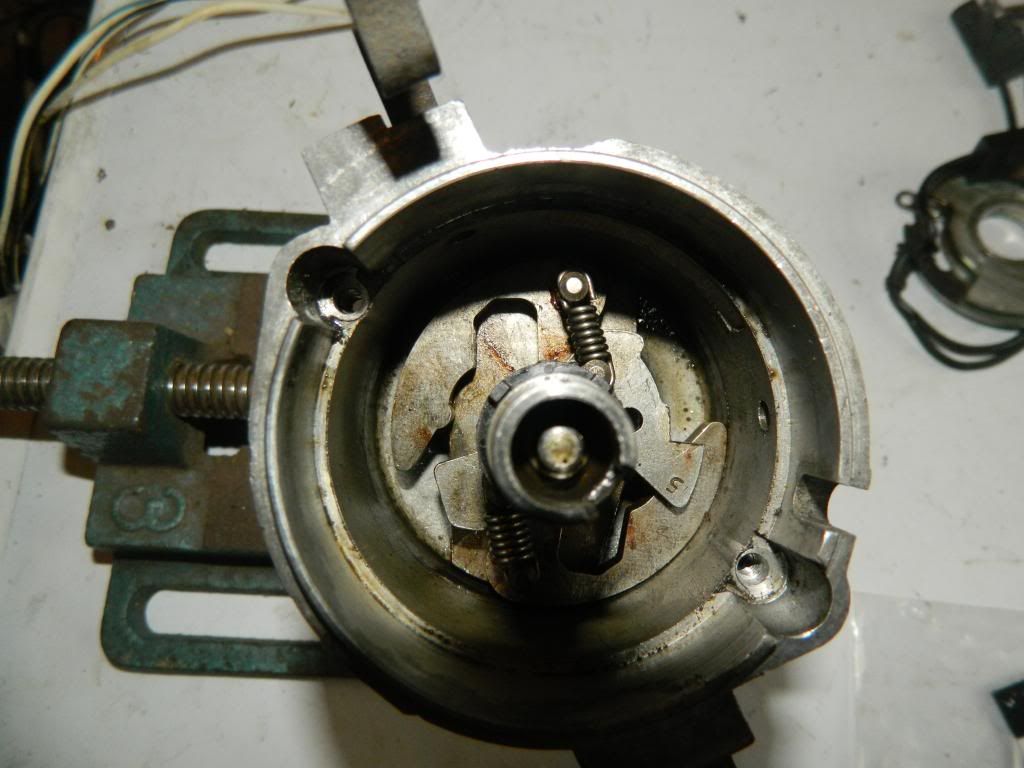 Weights and springs.  New springs. 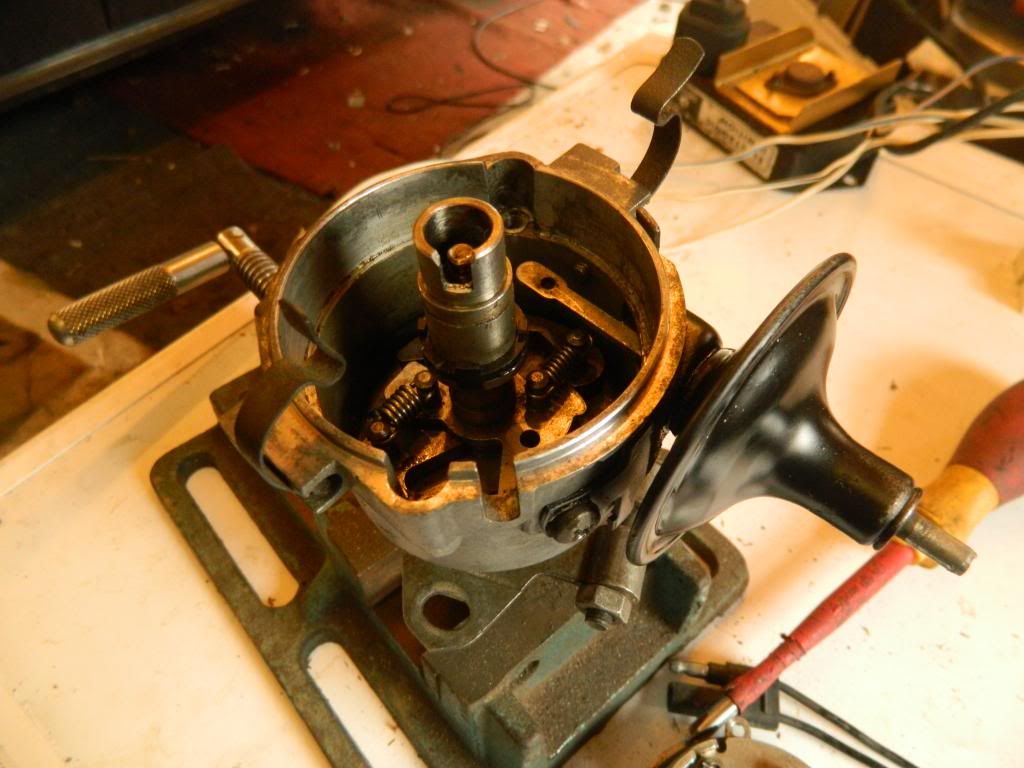 Fitted, vacuum advance from the 1800 dizzy cleaned up and fitted.  Magnetic pick-up plate fitted. 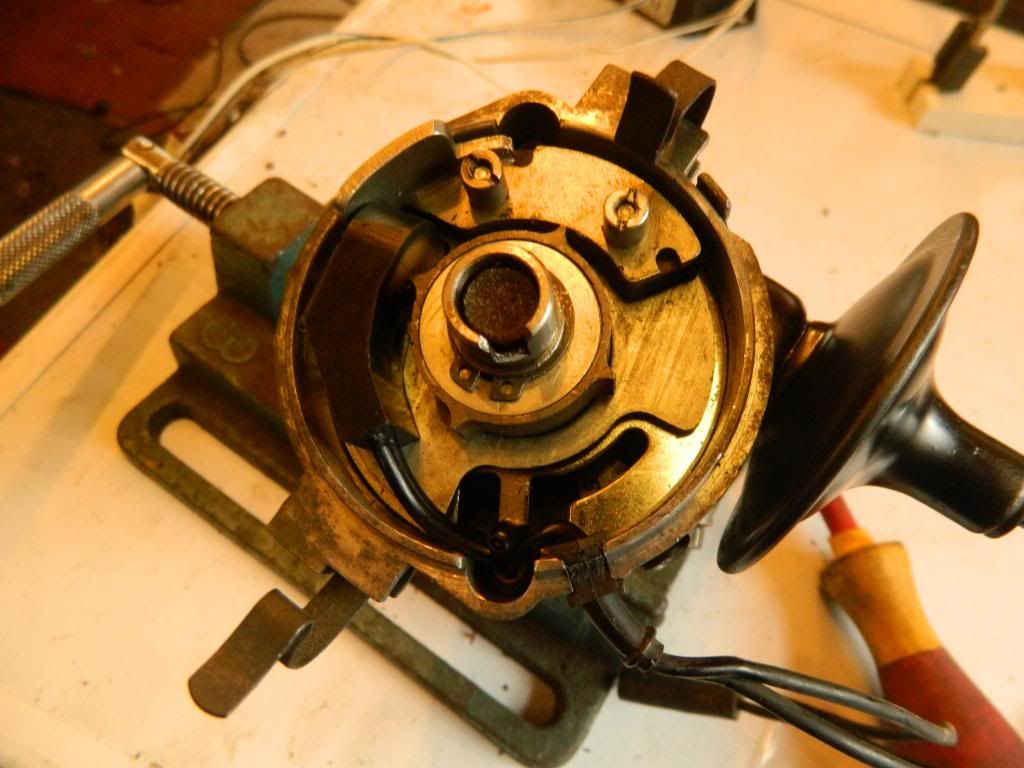 Reluctor in place - that's the toothed start wheel. As the teeth pass the pick up, a small voltage is induced - this will fire the electronics.  Dust cover and red rotor arm fitted. 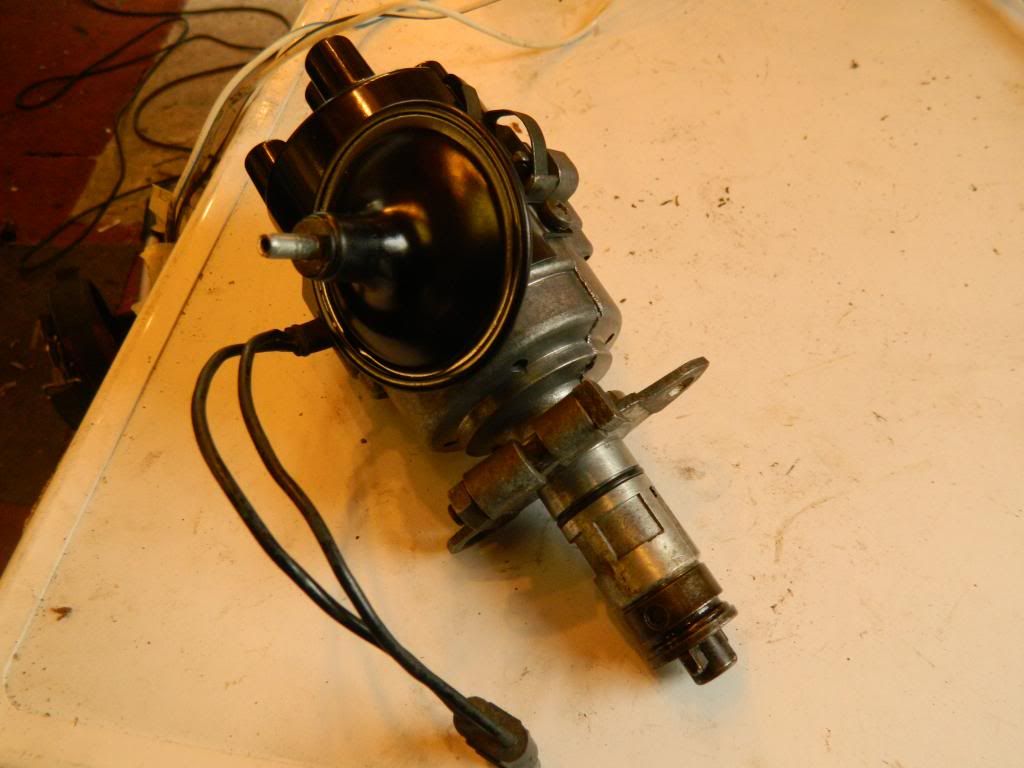 And finished. Quite tidy if I do say so myself. That'll do for a start - more in a mo. Chris. |
|
|
|
Post by Penguin45 on Mar 16, 2013 22:31:04 GMT
The electronics had been quietly accumulating at the same time. The main problem is that Chrysler/Sunbeam/Talbot is all but extinct in the UK. The module was found on eBay. The wiring loom was tracked down to a rally preparation company in Esher. A ballast ignition coil came from a local Mini specialist. The double ballast resistor eventually came from the US, courtesy of ROCKAUTO. £6 for the resistor, £26 p+p........... 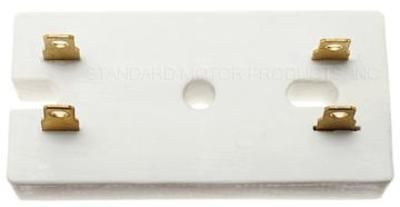 This was not a bargain............  Anyway: 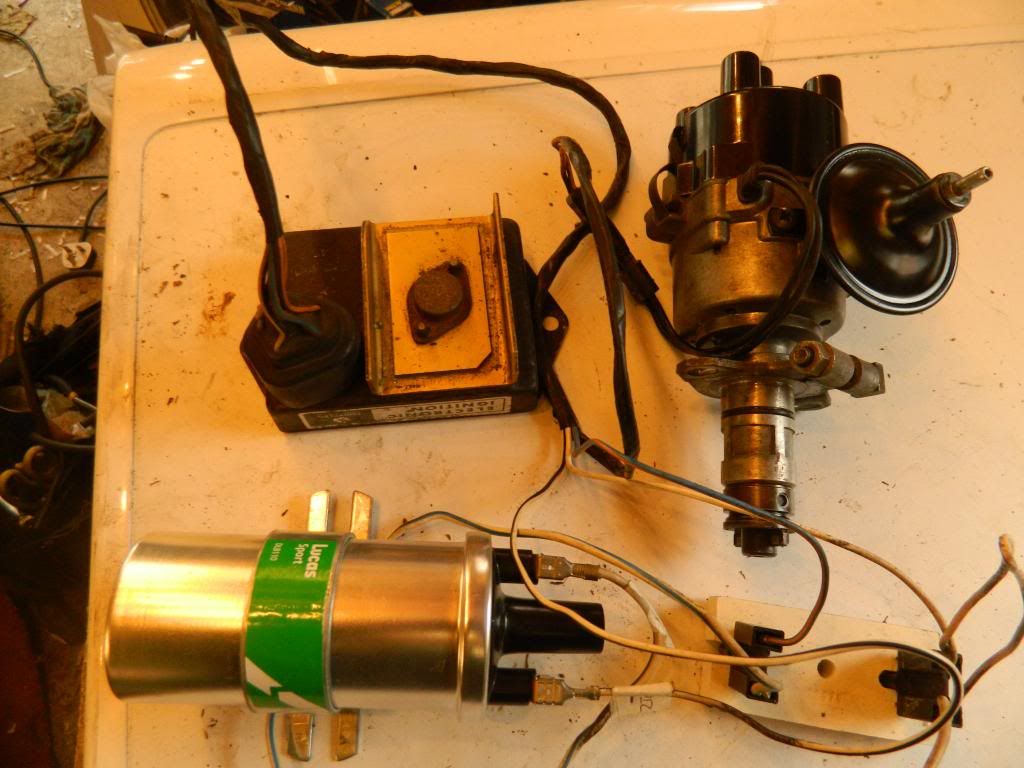 This is the mock up.  And mounted in the car. Run in a live and off we go. Err, no, not actually. Ady kept saying "But it's totally reliable", as we checked round and round the circuitry. No it isn't. I suspect that the ancient module and wiring loom didn't do us any favours. The loom uses several bespoke plugs and connectors, so making another loom from scratch wasn't an option. We retired defeated. However, the old cogs were still turning as I contemplated a way to do this with modern (ie - still available!) components. Further research (well, a good googling) suggested that the GM HEI set up worked on a reluctor trigger, could still be bought, had a small, discreet 4 tag module and no special connectors. However trying to actually buy one in the UK led to a string of silly prices. The above mentioned RockAuto supplied one for £16, from their European distribution centre, so p+p was only £6. This WAS a bargain.  I had to get a proper electronic ignition coil as well. So, now we were all ready for Plan B. 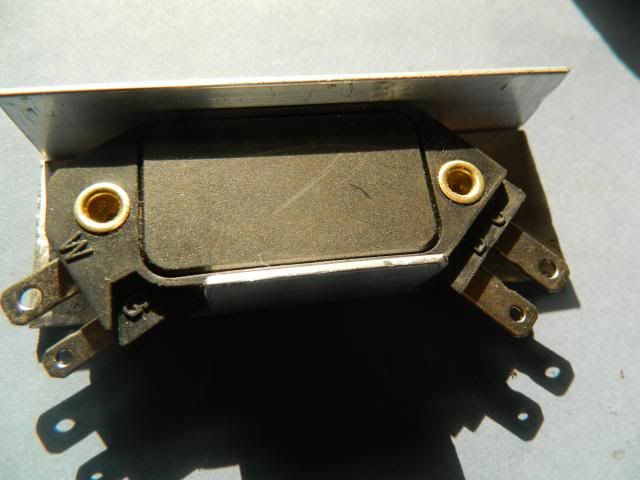 Ignition module, mounted in aluminium heat sink with plenty of gooey heat transfer compound. 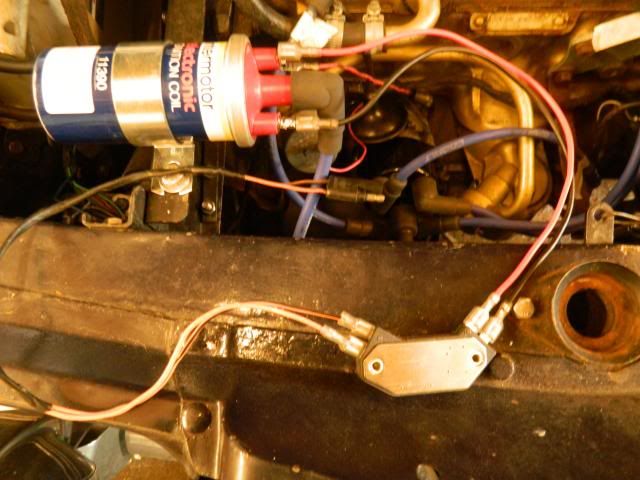 Wired it all up.  Hid the module under the slam panel. Turned the key and it ran! Timing is approximate at the moment, but it's close. Opening the throttle above about 2.5k rpm led to lots of popping and banging....... The GM HEI is triggered by the falling negative signal from the reluctor, which generates a very crude AC voltage. Reversing the output wires from the distributor solved this problem instantly. Mike Jordan has broken his dishwasher, so a deal has been struck to do the timing in exchange for the repair. ;D Hopefully we'll be able to roughly map the advance curve, as I know that David is interested in this. Having mentioned David, he and I have been discussing this by email over the last few weeks and I'd like to say a big "Thank you" to him for his work, research and advice which has kept me on the right path with this. Chris. |
|
|
|
Post by dave1800 on Mar 17, 2013 0:54:32 GMT
Well done Chris, success at last. The beauty of the reluctor triggers is that there are no electronics inside the hot distributor so should be reliable.
For others tempted to go the electronic route just remember the extra voltage puts strain on the distributor cap, rotor arm and spark plug wires so these need to be good quality items.
Thanks for the kind remarks, but it's you who has done all the hard work and had the determination to see it through!
Regards
David
|
|
|
|
Post by Penguin45 on Mar 17, 2013 1:04:24 GMT
A few random thoughts learned from this project.Lucas distributors. A 45D will replace a 25D on a 'Crab. It's a "B" series engine, so the originals ran a DM6. Therefore, the 25 and 45 will replace the DM6. A 59 will replace any of the above, with the electronics already integral to the dizzy. You could drop one into a 1955 Wolseley 15/50 and with an appropriate coil, it would run! The 45DM I used was fitted by Rootes - Hillman, Singer, Sunbeam, Talbot and Chrysler. It uses the same drive dog, so therefore physically fits our engines as well. Rootes also used a Bosch dizzy on the same engines. By extrapolation, that distributor could be fitted to a "B" series. How you'd rig the advance to suit, I don't know. Getting confused yet? My head was starting to spin as the information mounted. Weights. They're all the same, across each type. One fits all 25Ds, one fits all 45Ds etc. Therefore, the only control over the advance which you have is the stop on the cam and the advance springs. The vacuum advance units have a few different part numbers, so their action may vary. I have not got to the bottom of this yet. When you stop and think about the application for any given dizzy, it's really quite straightforward to adjust any other dizzy to suit - you just need the right springs. Electronic modules. This got quite complicated, before the epiphany. Your engine is dumb. It really doesn't care where the spark come from, as long it arrives at the appropriate time. The Chrysler research was interesting in as much as one unit fitted hundreds of models for the best part of twenty years. This implied that the distributor was still in charge of the advance curve and was really a box in charge of making an explosion. The GM HEI unit I used is a 4 tag unit, and the above comments still seem to apply. This comes in 5 and 7 tag variants, but still uses a "two in, two out" to produce the signal. The additional tags are used to run tachos and various other sub-circuits. They are moving towards full digital control however - the dreaded ECU. For more vintage stuff, Lucas did produce its own electronic units (excluding the Opus system, which reinforced their position as the Prince of Darkness), Luminition were off and running in the 70's, Sparkrite started back then as well. Even now, there are proprietary aftermarket systems around, like GAMMATRONIX. No idea if the stuff's any good. Which does lead on to the "popular" aftermarket ignition units. SimonBBC, Powerspark, Petronix and some others. These are "hall effect" systems. They are all very compact, so fit under the distributor cap, thus preserving the original look. They are very well marketed, but I have serious doubts, based on my personal experience. I have had units die from all of the above companies. After-market service can best be described as variable. Pertonix were laughable, SimonBBC was excellent. However, a free replacement unit doesn't address the basic problems. The units seem to be vulnerable to heat and electrical spikes. The voltage control on our cars isn't really all that clever when you get down to it. Having become an adopted Yorkshireman (Just like the Scots, but we've had the generosity beaten out of us.), I should say that you will get what you are prepared to pay for. The Mallory, 123, MSD, MegaSquirt systems all have an excellent reputation and this is reflected in the price. Given that I don't intend to go rallying or racing, I can't reasonably justify the expense for my 4k miles a year. I have rather more confidence in components developed and used by manufacturers. Given the demands of volume production, they have a vested interest in reliability, so hopefully what I've built out of regular production components will prove to be reliable. We will see! I hope that gives a little food for thought and perhaps discussion. Chris.
|
|
|
|
Post by Nick RS on Mar 17, 2013 18:17:54 GMT
Chris,
Impressive reading, most of it goes over my head to be honest but impressive nonetheless. Mine has a 123 system which is one of the mods I am very pleased with. When it's running it always pulls cleanly across the rev range and feels strong. No car activity for me for two weeks now due to family commitments and indifferent weather.
Spring is on its way I hope - Nick
|
|
|
|
Post by Penguin45 on Mar 17, 2013 21:23:50 GMT
Cheers, Nick.
123 is supposed to be excellent. Chris the Painter has one on his MGB Roadster and is very pleased with it. However - £250.
I reckon that with a bit of patience (finding the dizzy will be the hard part), you could rattle this up for around £65.
Spring had better not be too long - there's a load of paint rectification to be addressed.
Chris.
|
|
|
|
Post by threelitre on Mar 18, 2013 10:18:09 GMT
So what was the reason to choose a GM system instead of adapting a Maestro or Metro 59D with the electronics all attached to it's side (or an earlier version where it is separate)? I know the A+ block had another clamp, but from your post I gather the internals might be a possible swap? The electronic distributors in the Maestro is very reliable to start with - and possibly easy to source in the UK.
Regards,
Alexander
Edit: The 123 has one more trick in it's box, as it does not rely on weigths or springs for timing, one of the genuine reasons to be more expensive than others.
|
|
|
|
Post by dave1800 on Mar 18, 2013 13:13:02 GMT
I think Chris likes a challenge  He is now an ignition expert - remember where he was a few months ago, real progress! regards David So what was the reason to choose a GM system instead of adapting a Maestro or Metro 59D with the electronics all attached to it's side (or an earlier version where it is separate)? I know the A+ block had another clamp, but from your post I gather the internals might be a possible swap? The electronic distributors in the Maestro is very reliable to start with - and possibly easy to source in the UK. Regards, Alexander Edit: The 123 has one more trick in it's box, as it does not rely on weigths or springs for timing, one of the genuine reasons to be more expensive than others. |
|
|
|
Post by Penguin45 on Mar 18, 2013 20:01:24 GMT
True, I do enjoy a challenge. I enjoyed the research as well. Adrian having convinced me to go down the Chrysler route initially meant that I had bought the 45DM and set it up to match the 41415 of the MkIII. When we decided that the electronics could not be made to function, the GM HEI offered a modern, available and inexpensive alternative. I couldn't let a perfectly good distributor go to waste, either!  The electronic 59Ds are now quite rare and are getting rather expensive when they do pop up. I was also unsure as to whether or not I could match the curve. I think it's based on the 45D, but I didn't know for certain. Chris. |
|
|
|
Post by kelsham on Mar 19, 2013 8:46:18 GMT
I have been thinking back, you do as you age. I was trying to remember occasions on which I had been let down by the points system on cars I have been driving.
First I can remember is on a Bedford Dormobile in 1962, it had just returned from a garage service and began to misfire near Newport Pagnell, made it back to Staines. I believe the garage had adjusted the points badly.
Forward to 1986 I fitted a set of points to my Sons TR7 a few miles later he called home, broken down, I went out in the Landcrab and towed him home. I discovered the tag to the points had worked out from behind the spring, poor fitter, poor design? you decide.
Then to present day, had problems with the Landcrab, the points kept closing up traced to substandard points sets.
I went out yesterday and was delighted with the way the old girl pulled and drove.
I will let you all test out the new systems for a while yet. My gut feeling is you will need to fit fuel injection to make worthwile improvements.
Luddite follower, Kels.
|
|
|
|
Post by Penguin45 on Mar 19, 2013 21:40:02 GMT
Hi Kels,
If you have the gift with points and timing and can find decent quality parts, fair play to you, carry on. I haven't....... All this is about is finding a fit and forget solution so I never have to play with the timing again. ;D ;D
Fuel injection? It'll be diesels next!
Chris.
|
|
|
|
Post by dave1800 on Mar 20, 2013 0:38:49 GMT
Kels Chis has found a supplier of electronic ignition herethat still makes use of the contact breaker. However instead of the breaker passing the inductive coil current it simply acts as a trigger. I used something like this for over 100k miles and only needed adjusting a couple of times to compensate for the heel wear. If the ignition unit fails then you can convert it back to the conventional set up in 30 seconds or you could arrange switch to change it over. It is available as positive or negative earth options. regards David Hi Kels, If you have the gift with points and timing and can find decent quality parts, fair play to you, carry on. I haven't....... All this is about is finding a fit and forget solution so I never have to play with the timing again. ;D ;D Fuel injection? It'll be diesels next! Chris. |
|
|
|
Post by dave1800 on Mar 20, 2013 0:52:55 GMT
Chris Now there's an idea for a future project! It makes for fascinating research, which you seem to like, trying to overcome fuel timing issues for the shared inlet ports which Rover finally achieved with the very last A+ engines that had multi-point injection. There are now similar solutions out there for the MGB. Or how about using a wide-band air fuel monitor and polishing the SU needles to get the right profile for your individual engine. Together with programmable ignition there are report of quite considerable improvements in performance and economy possible. I think Rover's foray into fuel injection with the last of the Minis was more about meeting emission standards than bettering the engine's BHP with the SUs. Regards David Fuel injection? It'll be diesels next! Chris. |
|
|
|
Post by Penguin45 on Mar 25, 2013 0:47:44 GMT
I suspect that I may not want to go that far, David. No doubt some obsessed MGB owner will be working on it; to go with the turbos (yes), lambda sensors (yes) that they are beavering away on.
I like a quiet, simple life, really.
Today I spent a couple of freezing hours in the garage with a strobe and induction sensor, dialing it all in properly. Timing settled at a hair before 12 degrees BTDC when I finished. Had to tweak the idle afterwards, but the car seems quite happy; starting easily and coming up to temperature quickly. Plenty of power, with improved low/mid pick up. Not that MrsP will notice, mind.
I had intended to deal with the tie-bar bushes on the off-side, but I'm afraid it was just too d@mn cold.
Chris.
|
|
|
|
Post by dave1800 on Mar 25, 2013 12:04:52 GMT
Good to hear it's running well now after all that effort. Hope the weather improves soon. Regards David Today I spent a couple of freezing hours in the garage with a strobe and induction sensor, dialing it all in properly. Timing settled at a hair before 12 degrees BTDC when I finished. Had to tweak the idle afterwards, but the car seems quite happy; starting easily and coming up to temperature quickly. Plenty of power, with improved low/mid pick up. Not that MrsP will notice, mind. I had intended to deal with the tie-bar bushes on the off-side, but I'm afraid it was just too d@mn cold. Chris. |
|












 I had to get a proper electronic ignition coil as well.
I had to get a proper electronic ignition coil as well.






